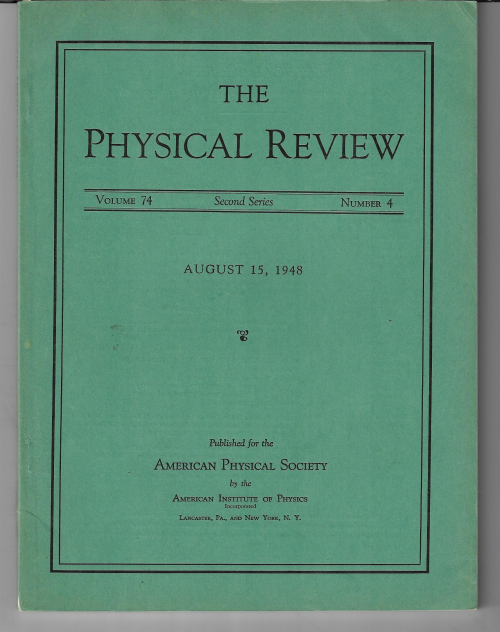GAMOW, George. "Origin of Elements and the Separation of Galaxies", in Physical Review, volume 74, no 4, 15 August 1948, pp 505-506, the issue offered in the original wrappers, Fine copy. $600
 See: Cosmological Constants: Papers in Modern Cosmology, edited by Jeremy Bernstein and Gerald Feinberg. New York: Columbia University Press, p. 114, 1986; 385 citations (Science Abstracts) "The hot universe is proposed to solves the nucleosynthesis problem", in V. F. Mukhanov, Physical Foundations of Cosmology, chapter 4; reprinted in A. Zee's Unity of Forces in the Universe, Volume 2; "These two 1948 papers by Gamow laid out the foundation for our present understanding of big-bang nucleosynthesis" --Rupert Anderson, The Cosmic Compendium: The Big Bang & the Early Universe, pg 56.
See: Cosmological Constants: Papers in Modern Cosmology, edited by Jeremy Bernstein and Gerald Feinberg. New York: Columbia University Press, p. 114, 1986; 385 citations (Science Abstracts) "The hot universe is proposed to solves the nucleosynthesis problem", in V. F. Mukhanov, Physical Foundations of Cosmology, chapter 4; reprinted in A. Zee's Unity of Forces in the Universe, Volume 2; "These two 1948 papers by Gamow laid out the foundation for our present understanding of big-bang nucleosynthesis" --Rupert Anderson, The Cosmic Compendium: The Big Bang & the Early Universe, pg 56.
The following interesting quotes are from Phillip James Edwin Peebles, "Discovery of the Hot Big Bang, What Happened in 1948", in The European Physical Journal H, 2014. ("The idea that the universe is filled with the thermal radiation now termed the Cosmic Microwave Background was discussed in eleven publications in the year 1948..."):
- "Gamow’s (1948a) proposal that element formation in the early universe was mediated by a sea of thermal radiation."
- "The title of Gamow’s (1948) paper shows he was also thinking about the role of thermal radiation in galaxy formation after element buildup." p 212
- "...(Gamow) proposes that this marks the start of the growth of mass concentrations such as galaxies. Gamow also points out that the matter density and temperature, which he takes to be the same as the radiation temperature, determine the time-independent Jeans mass of the smallest gravitationally-assembled clouds of baryons (Gamow and Teller 1939). The modern theory adds many details, but we see here early recognition of the important role thermal radiation plays in cosmic structure formation..." p 214
- "The starting idea [in the Gamow paper, above] is that element formation in the early universe would have to have been a rapid non-equilibrium process."--pg 221




Comments